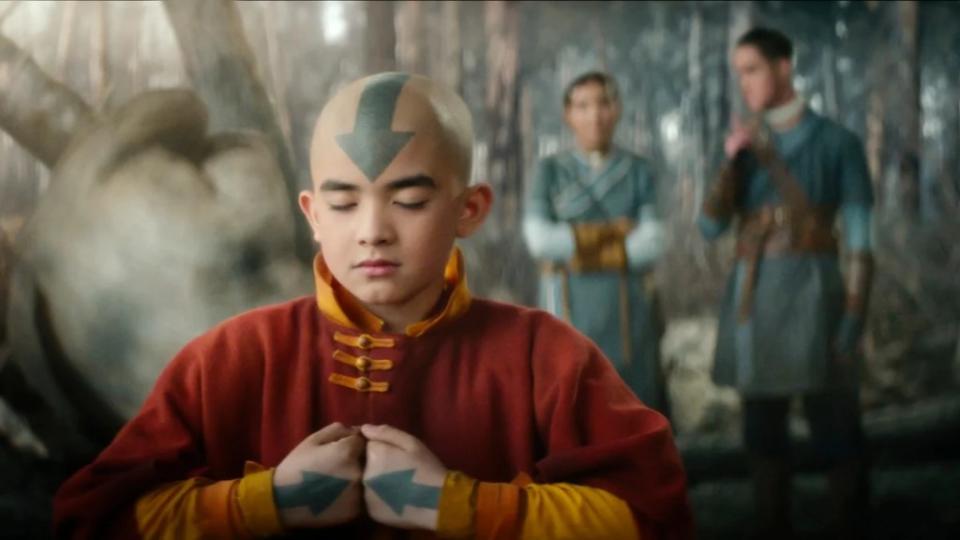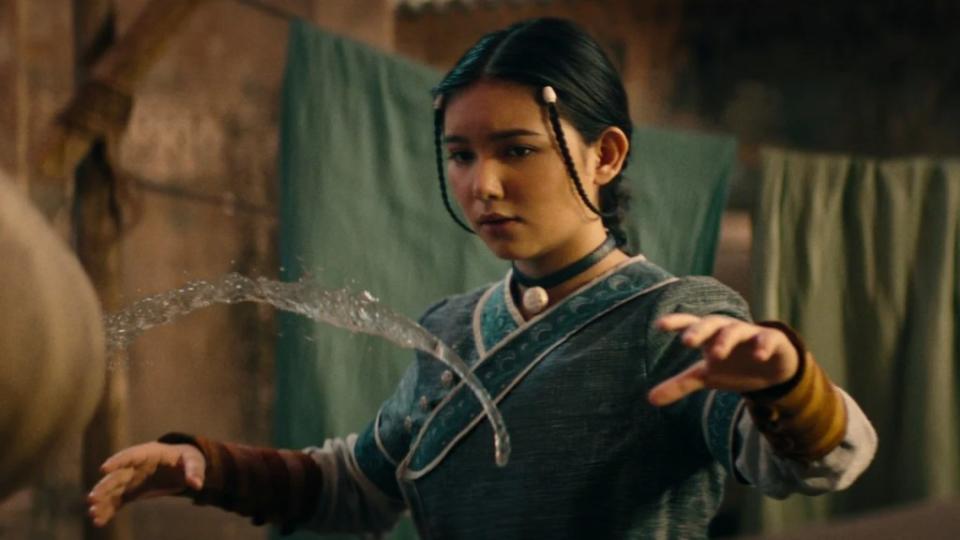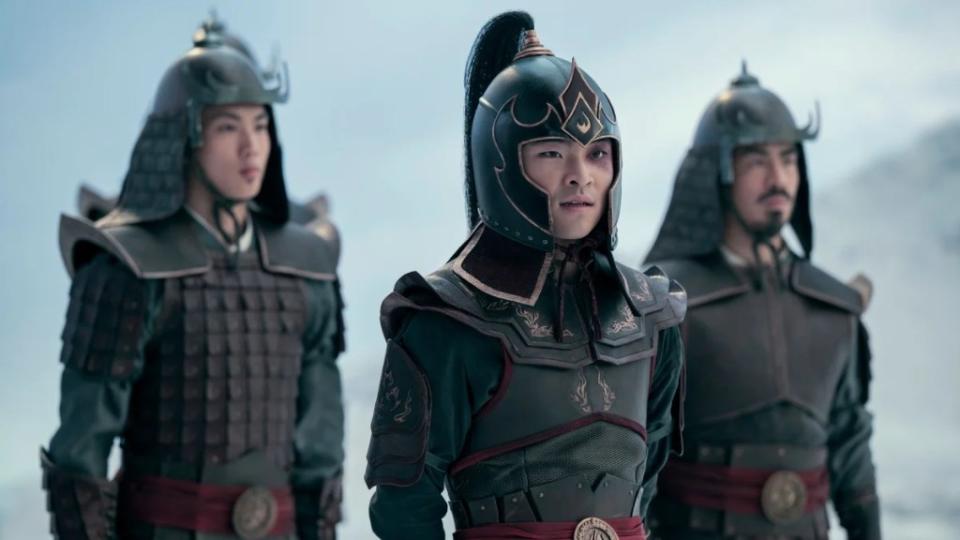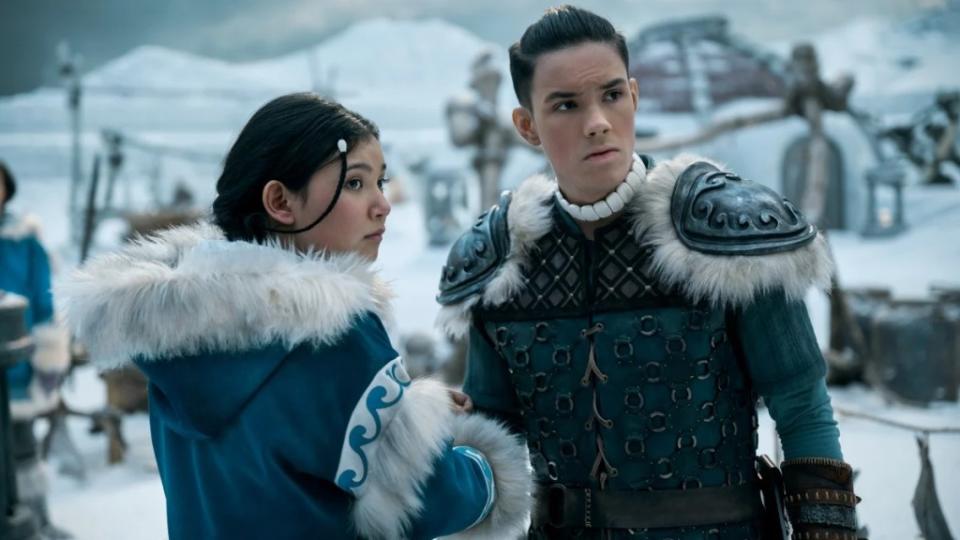Inside ‘Avatar: The Last Airbender’: How Netflix Turned an Animated Favorite Into a Faithful Live-Action Series
- Oops!Something went wrong.Please try again later.
- Oops!Something went wrong.Please try again later.
- Oops!Something went wrong.Please try again later.
When Netflix first announced plans for its own live-action adaptation of Nickelodeon’s “Avatar: The Last Airbender,” fans had good reason to be skeptical. After all, they had been here before. M. Night Shymalan’s 2010 take on the beloved property, “The Last Airbender,” was panned as a universal flop and was labeled one of the worst movies of all time by many publications, including Vanity Fair, Screen Rant and Digital Trends.
That white-washed and clunky film is a far cry from the ambitious and well-researched series Netflix brought to the screen. Rather than trying to cram the story of Avatar Aang into a commercially successful format, “Avatar: The Last Airbender” takes care to remain as faithful as possible to the tone, scope and themes of the original series.
“It was really, in as many places as we could, about going back to the animated series and ensuring we’re drawing from the source material,” Jabbar Raisani, the director of Episodes 3 and 4 who was crucial to developing the visual language of the show, told TheWrap. “We had a lot of fantastical storytelling to do, but we really wanted to ground it in reality.”
Above all else, Raisani said the goal was to make it feel like you were watching a “three dimensional version” of the original Nicktoon.
Accomplishing that took weeks of research into mid-1800s Asian costuming, over 20 sets of the same costume for its lead star, the creation of a whole array of breathing techniques and stunt work shorthands, a 98-piece orchestra, a month-long boot camp and a state-of-the-art soundstage.
This is the story of how Netflix’s live-action “Avatar: The Last Airbender” was made.

Capturing the reality of a cartoon
By and large, the first season of Netflix’s “Avatar” tells the story of Book 1 of the original animated series.
Set in a world where certain people known as benders have the ability to control the four elements, the series follows Aang (Gordon Cormier), a young Airbender. When Aang learns that he’s the Avatar — the reincarnated bending master capable of learning all four elements and bringing peace to the world — he flees and is later forced to freeze himself to escape a storm. Unbeknownst to Aang, the Fire Nation attacks the Air Temple while he’s away. The original series begins in earnest 100 years later when an unfrozen Aang learns that the Fire Nation has murdered everyone he loves and countless others in their path to conquering the world. Only 12-year-old Aang and his band of misfit friends stand in the way of this rampage.
Netflix’s interest in adapting this series first became known in 2018 when the streamer announced that a live-action series was in development and that production was scheduled to start in 2019. Originally, the Nicktoon’s creators Dante DiMartino and Bryan Konietzko were signed on as showrunners and executive producers of the project. They departed the show in 2020 due to creative differences, stating that there was “no follow through” on Netflix’s promise to support their creative vision.
“This is probably the most difficult decision I’ve even made,” Konietzko posted at the time. “But there was no doubt in my mind it was absolutely the right choice.”
Afterwards, Albert Kim signed on as showrunner, citing that his priority was “authenticity” above all else. Before Kim began working on the series, he first had to decide who this adaptation was for. “We went in thinking this was a show meant for all ages, not just families, not just kids, but everyone ranging from the youngest to the oldest,” Kim told TheWrap.
Keeping a broad target audience proved “tricky” when starting to bring the darker elements of “Avatar” to life.
“You’re dimensionalizing everything in the story. There’s an immediacy and visceral-ness that happens when you tell a story in live-action that isn’t always there in animation,” Kim explained. “It’s one thing to draw a 12-year-old Aang and a 14-year-old Katara. It’s another to see live human beings who were 12 and 14 playing those characters … It can have a much bigger emotional impact. We were aware of that all the way through.”
This awareness meant quickly pulling away from certain shocking moments in the original, like Aang finding the skeleton of his best friend and mentor, Gyatso (Lim Kay Siu). But there was one area where “Avatar” couldn’t shy away from the horror.
“I always knew that I wanted to start with the Fire Nation attack on the Southern Air Temple because, as we all know, everything changed when the Fire Nation attacked,” Kim said.
Unlike the original series, the Netflix adaptation starts by depicting the vicious genocide of the Air Nomads. Directed by Michael Goi and written by Kim, Michael Dante DiMartino and Bryan Konietzko, it’s one of only two episodes that contains a writing credit from the original series’ creators.
“That’s not something we got to experience in the original animated series. We were able to show it and use that to, essentially, set the stakes for this whole world,” Kim said. “These are people like you and me, and they’re going through the horrors of war. We needed to know what that felt like.”
There’s another key reason why Netflix’s “Avatar” doesn’t exactly play out like the original: timing. As opposed to the animated version’s 20 self-contained episodes per season, the first installment of the Netflix series only has eight hour-long episodes. That forced Kim and the rest of the writing team to get creative, which started by laying out all the stories from Book 1 and looking for thematic similarities.
“You can take a character like Jet [Sebastian Amoruso], who is a person who’s good at heart and has been pushed to do some extreme things because of war. Then you take a look farther down the line at the Mechanist [Danny Pudi], who’s also a character who has good intentions, but has been pushed to do some bad things because of the war,” Kim explained. “When you put them side-by-side, you realize they’d be on opposite ends of the table, and that created conflict. So we would bring those elements together.”
Once the general story was laid out, the real work could begin.

The logistical demands of Water, Earth, Fire and Air
The scale of this series paired with the child labor laws that applied to its young cast required the team to meticulously plan out every detail.
To prepare for this action-packed show, the stunt and VFX teams worked closely alongside the writers. A stunt language and a specialized breathing technique were developed for each of the four bending disciplines — Water, Earth, Fire and Air. Each was based on a different style of martial arts. Firebending was inspired by the “very strong and dynamic” Northern Shaolin kung fu; waterbending was inspired by the “softer” Tai Chi; airbending by the “circular” Chinese martial art of Bagua; and earthbending was based on the “grounded” Southern China Hung Ga.
Adding to the complexity, the martial arts and stunt work around these four elements was also adapted to best suit each individual character. Though Katara (Kiawentiio) and Master Pakku (A Martinez) may both be Waterbenders, it was imperative to make their bending styles look different to reflect where they were from and how they learned to bend.
The cast then attended a month-long boot camp. Both Ian Ousley, who plays Sokka, and Dallas Liu, who plays Prince Zuko, started the series as world-class martial artists, but Cormier and Kiawentiio had more to learn. Raisani noted that Kiawentiio worked “really hard” to perfect her training, and it wasn’t unusual to see Cormier practicing with a version of his Airbending staff in between scenes.
Then it came time to film. Due to a combination of “creative and financial factors,” the series filmed two episodes at a time. This setup allowed the series to use certain sets for longer, such as the Earth Kingdom city of Omashu, which is featured for roughly a fourth of Season 1’s runtime compared to the one episode the location occupies in Book 1. Referred to as block shooting, this process of filming multiple episodes at once has been utilized on other massive shows like “Game of Thrones,” “House of the Dragon” and “Stranger Things.”
Adding to the challenge, the series was shot during the pandemic, which created a “gnarly” logistical challenge, and the team had to navigate through filming restrictions and education requirements for minors.
“It wasn’t an easy process. But it was one that everyone on the cast and crew approached with a level of excitement and joy because everyone was just so excited about the story,” Kim said.
That excitement carried over to how the four main leads spent their time. Kim noted that it wasn’t uncommon for Cormier, Kiawentiio, Ousley and Liu to remain on set even when they weren’t working. “All of them became such close friends so quickly, and they’re at that age, all of them, where that happens very easily,” he said.
For a period of time, Kiawentiio even followed Kim around the set, going to meetings with him and “just absorbing everything.” “I loved having her around,” Kim said.

The small details that make a big world
The reason the world of “Avatar” feels so fully realized is due to the small, carefully crafted details of the show’s costuming, score and VFX.
Much like the stunt team took care to develop a specific martial arts language for each bending concentration, costume designer Farnaz Khaki-Sadigh tried to make the outfits of the series feel as authentic as possible. That meant weeks of research that involved everything from watching old samurai movies to studying how armor moves during fight sequences to speaking to elders from indigenous communities in Vancouver.
“A lot of the references come from the mid-1800s in Asia, Southeast Asia and Central Asia,” Khaki-Sadigh told TheWrap. “I wanted it to look realistic, and I wanted it to be respectful of each of the cultures that we use and reference in the show. But at the same time, I also wanted it to be very much honoring the animation for the fans.”
The wardrobe for the Fire Kingdom was more militaristic and nodded to Japan and South Asia. With its metals and use of rich materials such as gold and silk, the costuming is supposed to channel a volcano and mirror the wealth of this dominant nation. Metal and leather also appear in the costumes for the Earth Kingdom, showing that the Earth Kingdom and Fire Nation are still trading with one another during this time of war. The Water Tribes were inspired by Inuit culture as well as Northern Scandinavian Indigenous communities. Animal pelts are often employed as protection against the frigid temperatures of these tribes. Conversely, the Air Nomads — which are inspired by Buddhist monks — use no animal products to align with their vegetarian values and are often dressed in flowing, natural fabrics.

Then there was the matter of Cormier’s many growth spurts. “Gordon was growing as we were filming, so pretty much every three weeks we had to make a new pair of pants or a new shirt because he’d show up to set and his seam would be like one inch too short,” Khaki-Sadigh said. “I think he has close to 20 sets of [his main] costume.”
This level of care and attention was also brought to the project’s compositional work as well as its visual effects. Composer Takeshi Furukawa, who previously worked on “Star Wars: The Clone Wars” and “Star Trek: Enterprise,” was brought onto the series right when shooting began, a rarity in the world of television. Furukawa was able to use some of the original work of the original series’ composer, Jeremy Zuckerman.
“I approached it as if I’m just filling in his shoes. This is his musical world, first and foremost, and hopefully, I would be a decent substitute,” Furukawa told TheWrap.
The series wanted to capitalize on Furukawa’s orchestral background to give this story the gravitas it required. This led to utilizing a 98-piece orchestra as well as a 72-piece choir, which is bigger than “a lot of” blockbuster films.
“It shows Netflix’s commitment and their support for the filmmaker, and even lower-tier talent like myself, to make sure we have the resources to realize what we want,” Furukawa said. “It’s all in favor of the show, though, obviously.”
The composer also worked closely with the effects team to make sure the big action moments in the series carried the right degree of emotional depth. “When I started writing, it was a very iterative process,” Furukawa said. He noted that he went through edits “every week,” adjusting musical cues and tweaking melodies to ensure they matched the new VFX that were coming in.
As impressive as these details may have been on their own, they were all created first and foremost to serve the story at the center of “Avatar: The Last Airbender.”
“Story is king. We’re always looking at what is the story that we’re telling?” Raisani said. “It really all needs to marry together. And if one thing starts to dominate over the others, then we’re really not doing our job.”
Though Netflix hasn’t announced the fate of “Avatar,” showrunner Albert Kim has plans for more seasons.
“Thematically the show and the season is all about hope and represents the return of hope to a world that desperately needs it,” Kim said. “It’s setting up the change within our characters and within the world we live in, and hopefully setting that up for future seasons, where these characters can now move into the next phase of changing the world around them.”
“Avatar: The Last Airbender” is now streaming on Netflix.
The post Inside ‘Avatar: The Last Airbender’: How Netflix Turned an Animated Favorite Into a Faithful Live-Action Series appeared first on TheWrap.

